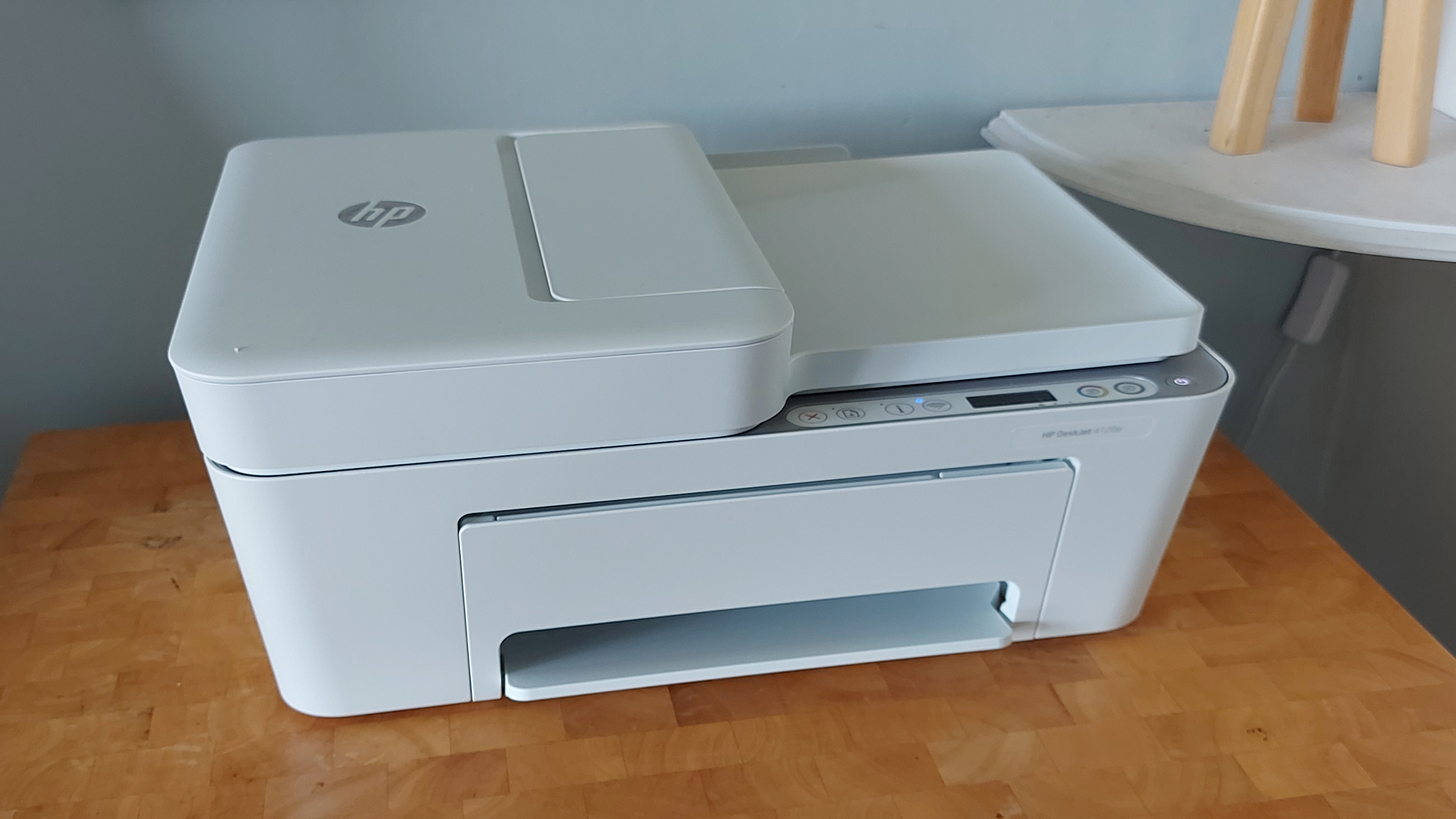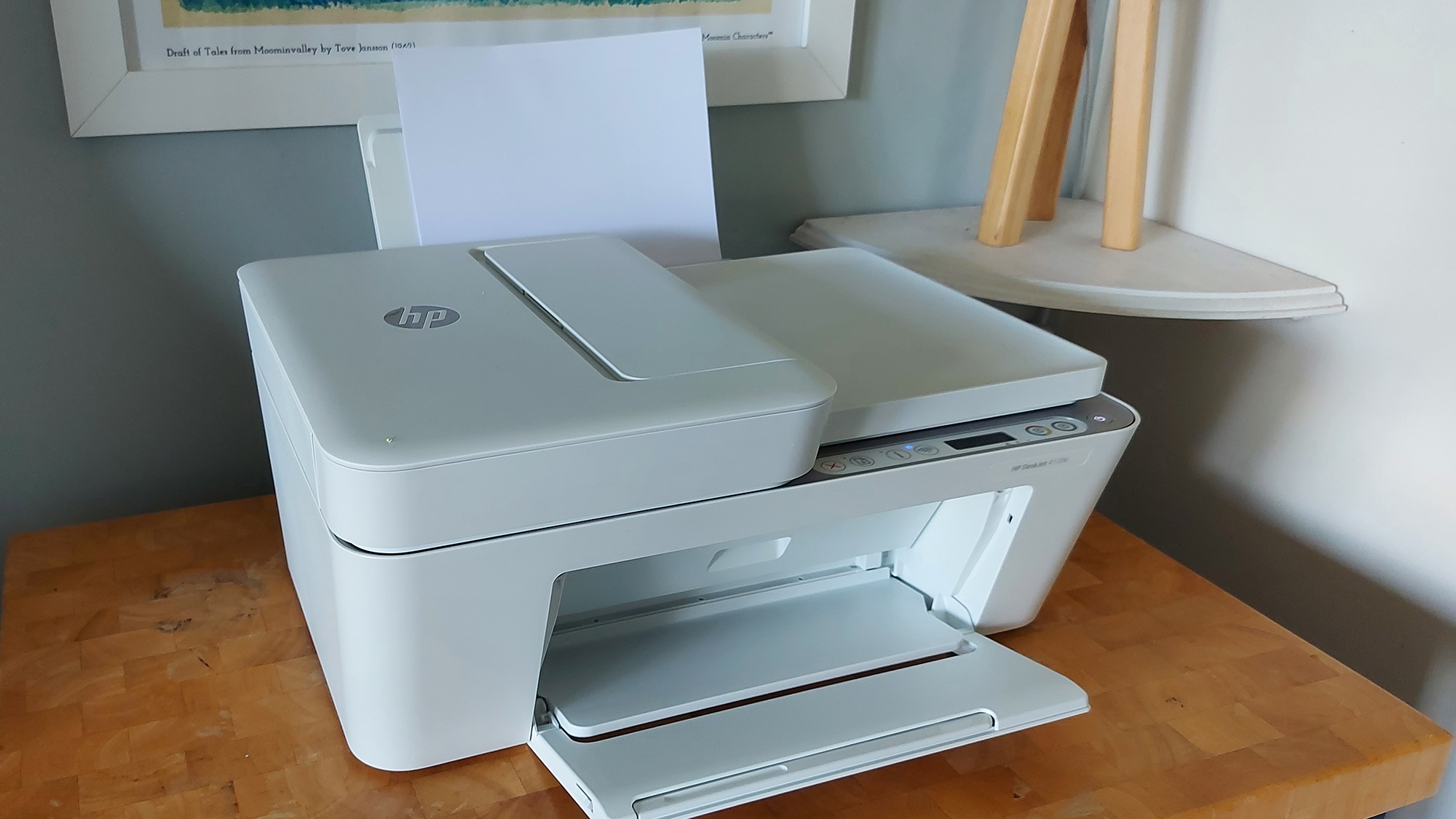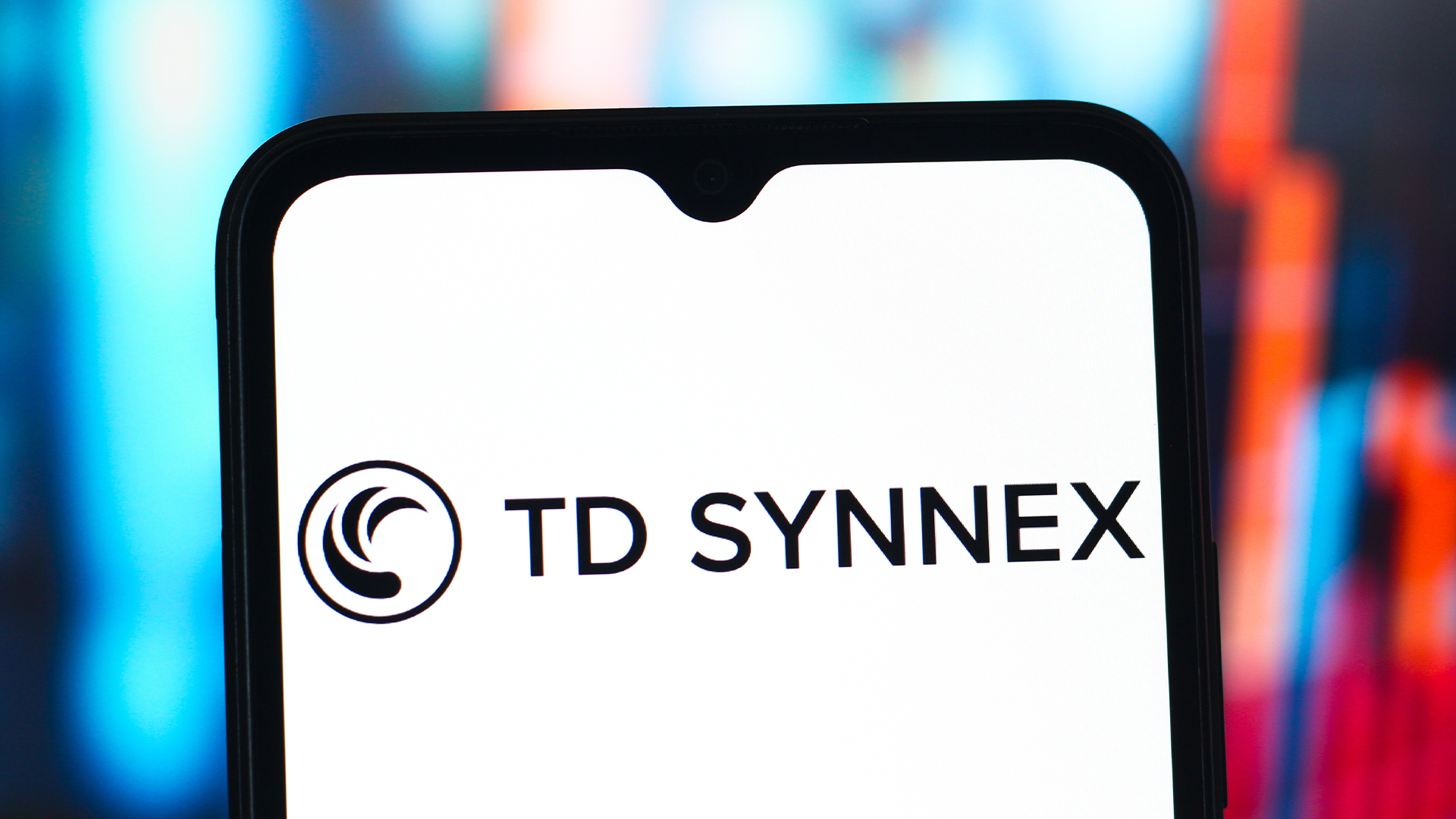HP Deskjet 4120e review: An incredibly cheap home office MFP
Cheap and very compact, but with slow speeds


-
+
Compact design
-
+
25-sheet ADF
-
+
Affordable to run on HP+ with Instant Ink
-
-
Slow speeds
-
-
Average overall print quality
-
-
No automatic duplex printing

The HP DeskJet 4120e has three main virtues: it’s fairly compact, simple to use and very cheap. At the time of writing, you can pick one up for under £60 exc VAT, with 6 months of HP+ and Instant Ink thrown in. Yet it’s a fully-fledged multi-function printer with a 1200 dpi print engine, a 1,000 page maximum monthly duty cycle and a 35-page auto document feeder on the scanner. Most IT teams and even some small business owners will probably discount it for being too cheap, but as a printer for remote workers, small offices and personal use, it makes a certain amount of sense.
When we say that it’s compact, we’re being relative, but it has a desktop footprint of roughly 26 x 39cm, expanding as the case slopes outwards to just under 34 x 43cm. With the rear input and front output tray extended it takes up more space, roughly 43 x 58cm, but these fold away neatly when not in use and make this a comparatively unobtrusive MFP.
Impressively, it doesn’t feel as cheap as it is. The output tray and extender wouldn’t take much to break off and we have some reservations about the paper input, but the body as a whole feels solid and the plastics robust. The paper input is our first hint that this isn’t a printer designed for heavy workloads. It only takes a maximum 60 sheets, and that’s at a push. At much above 30 you feel that you’re almost forcing them in between the lighter plastic flap that covers the input while not in use and the guides on either side.
There’s a USB port at the rear, but the 4210e is clearly designed to be used through Wi-Fi. Like other recent HP printers, the default way to set it up is through HP’s Smart smartphone app, which does a great job of taking you through the physical setup, connecting to the network, installing inks and paper and printing a test page. Weirdly, though, it only surfaced the auto-calibration routine after we’d printed a few documents, when most recent HP printers run it as standard, straight after setup.
Simplicity is one of the cornerstones of the design. There are just six buttons and a basic mono LCD display, which covers status and ink levels. With no real menu systems to work with, all configuration is through the smartphone or desktop apps, or a web-based control panel, and if you want to switch modes, change settings or install new firmware, that’s where you’ll need to head. Luckily, it’s all very straightforward and intuitive, and it’s unlikely that you’ll need to visit it much, anyway.
Sadly, we did. While the test page and other documents printed with no trouble from the smartphone app, we couldn’t get the printer to print anything from a Windows 11 laptop either through the default Windows driver or with HP’s Smart app installed. This may have been an isolated problem and was fixed by a firmware update, but it didn’t exactly leave us with much confidence as testing began.

If you’re looking for a fast printer, move on. HP’s stated print speeds are 8.5ppm monochrome and 5.5ppm colour, and though we saw higher speeds that this when we tested it, we wouldn’t go overboard in our praise. On our standard 24-page black text test at normal quality, the first page took 20 seconds to emerge with subsequent pages following at a speed of 10.5ppm. In draft mode, the first page took 16 seconds, while the speed for the remaining pages increased to 14ppm. That’s still one of the slowest monochrome performances we’ve seen in recent years. To make things worse, there’s no automatic duplex option. You can select double-sided printing, but you’ll be removing each sheet and re-inserting it to print the second side.
Sign up today and you will receive a free copy of our Future Focus 2025 report - the leading guidance on AI, cybersecurity and other IT challenges as per 700+ senior executives
Unsurprisingly, colour printing speeds are even slower. With a five-page test with a mix of black text and colour charts and business graphics, the first page took 44 seconds to drop, while the print speed after that was just 3ppm. A4 and 6x4in photos took 50 seconds to emerge with the print quality set to high. Nor should you expect instant photocopies; both black and white and colour copies took over 30 seconds to scan and print. Even scanning speeds are relatively slow, at nearly 25 seconds for a 300dpi colour scan or three minutes and 15 seconds for nine pages to be scanned through the ADF.
As for the print quality, it’s best described as solid. On the default ‘Better’ setting, text is crisp and black with good definition on plain paper, though with just a hint of fuzziness when printing on a light-coloured background. Text printed in draft mode is lighter and not quite so sharp, but still perfectly usable for most purposes. We spotted the very odd, thin white line creeping into business graphics, even after alignment, but nothing serious.
The 4120e will also handle photos, but don’t expect what you’d call true photo quality. At the Best setting on photo paper you get reasonable levels of detail, but the presentation is slightly flat, skin tones lack warmth and elements that should stand out with vibrant colours don’t. It’ll do for inset photos in a business document, but you wouldn’t want to print out marketing materials – or sneaky holiday snaps.
If you’re not planning to use Instant Ink, the 4120e also suffers from high running costs. Even with the XL cartridges, you’re looking at costs of 6.9p per black and white print, and 14p per colour print before VAT. As a result, the 4210e only makes sense with an Instant Ink subscription, and even then as a low volume printer. For example, on the Moderate plan you’d be looking at £4.49 for 100 pages per month, bringing the costs down (for either black and white or colour) to 4.5p per page per month. On the 300 page, £9.99 Frequent plan, that comes down to around 3.3p per page.
With HP+ and Instant Ink, the DeskJet 4120e could work as a cheap, low-volume, home office printer, where it’s biggest issues – slow speeds, average quality, no duplex – aren’t going to be deal breakers, and where features like the ADF will have some value.
For anything more, though, you have to wonder whether it’s more sensible and cost-effective to spend more for a printer that will cost you less over the long term and give you better performance as well. While the Epson EcoTank ET-3850 will cost you a lot more upfront, for instance, it might still work out cheaper over the lifespan of the printer as a whole.
HP Deskjet 4120e specifications
| Format | 1,200 x 1,200dpi A4 inkjet MFP, 1,200 x 1,200dpi flatbed A4 scanner |
| Print speed | Up to 8.5/5.5ppm mono/colour |
| Display | 34mm/1.5in LCD display |
| Networking | 802.11n |
| Connectivity | USB |
| Print type | Single sheet, single-sided |
| Tray size | 60-sheet, 20-card input tray |
| Recommended monthly duty cycle | 1000 |
| Dimensions | 428 x 579 x 261mm |
| Weight | 4.82kg |
| Warranty | 1yr RTB |
Stuart has been writing about technology for over 25 years, focusing on PC hardware, enterprise technology, education tech, cloud services and video games. Along the way he’s worked extensively with Windows, MacOS, Linux, Android and Chrome OS devices, and tested everything from laptops to laser printers, graphics cards to gaming headsets.
He’s then written about all this stuff – and more – for outlets, including PC Pro, IT Pro, Expert Reviews and The Sunday Times. He’s also written and edited books on Windows, video games and Scratch programming for younger coders. When he’s not fiddling with tech or playing games, you’ll find him working in the garden, walking, reading or watching films.
You can follow Stuart on Twitter at @SATAndrews.
-
 The Microsoft bug bounty program just got a big update — and even applies to third-party code
The Microsoft bug bounty program just got a big update — and even applies to third-party codeNews Microsoft is expanding its bug bounty program to cover all of its products, even those that haven't previously been covered by a bounty before and even third-party code.
By Nicole Kobie Published
-
 UK say firms say no to AI job cuts: 32% expect to hire more staff as leaders double down on ‘specialist roles’ and productivity gains
UK say firms say no to AI job cuts: 32% expect to hire more staff as leaders double down on ‘specialist roles’ and productivity gainsNews There's good news for British workers worried about AI job cuts, with new research showing that 78% of business leaders don't expect its to lead to a drop in headcount.
By Emma Woollacott Published
-
 TD Synnex launches new workshop to help partners drive AI adoption
TD Synnex launches new workshop to help partners drive AI adoptionNews The distributor’s new AI Game Plan will aid partners in identifying and prioritizing customer AI use cases
By Daniel Todd Published
